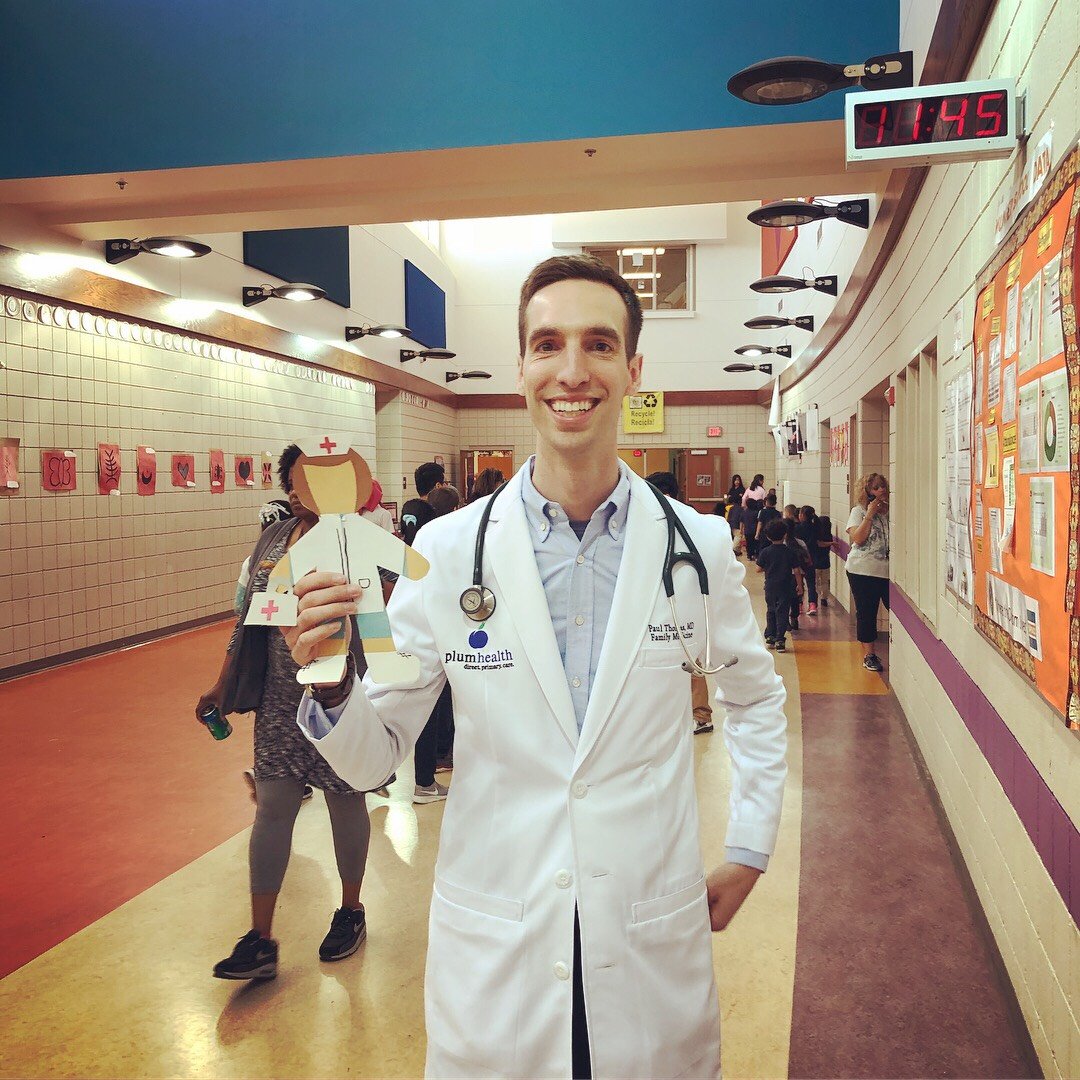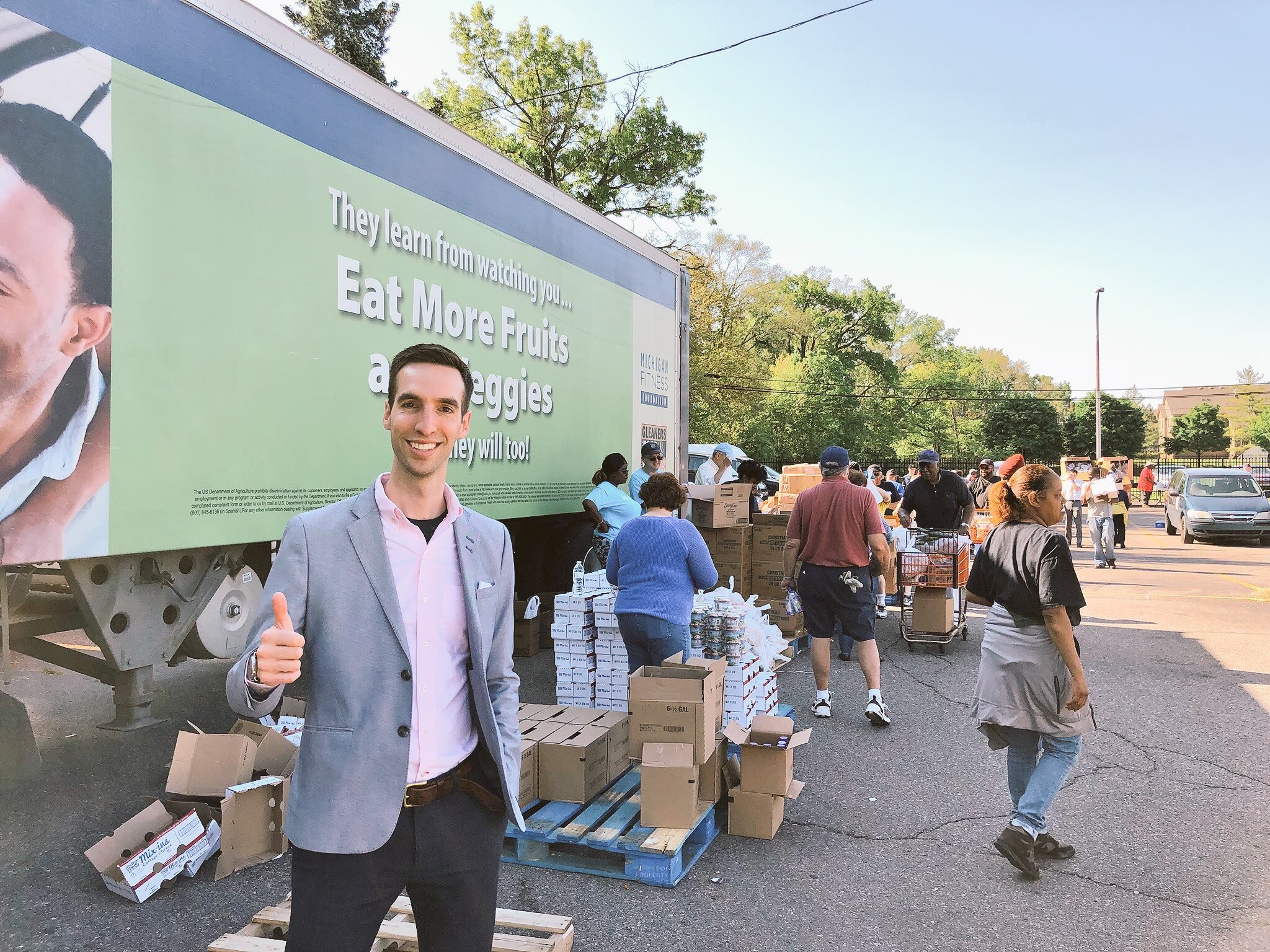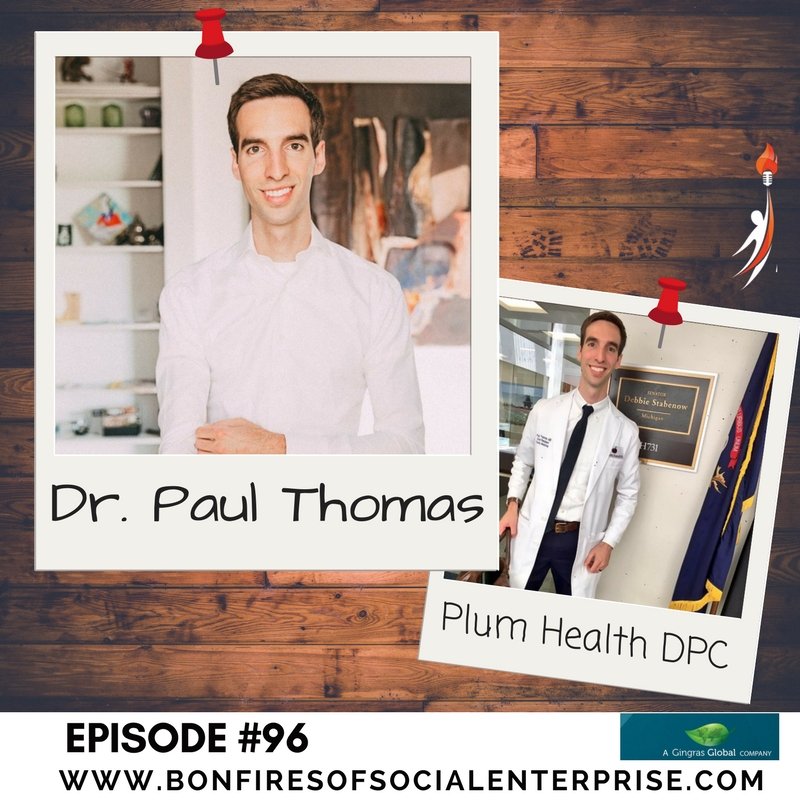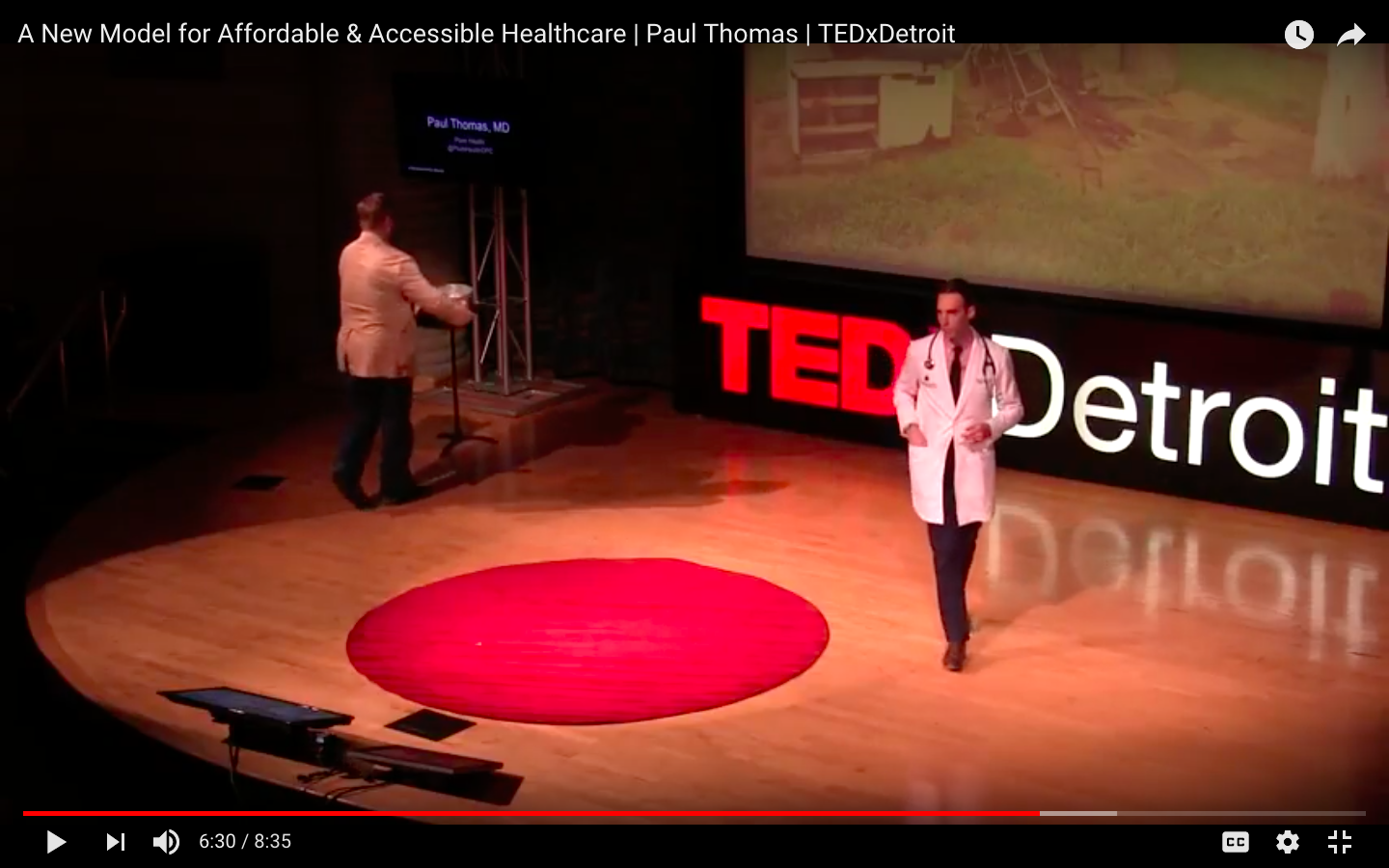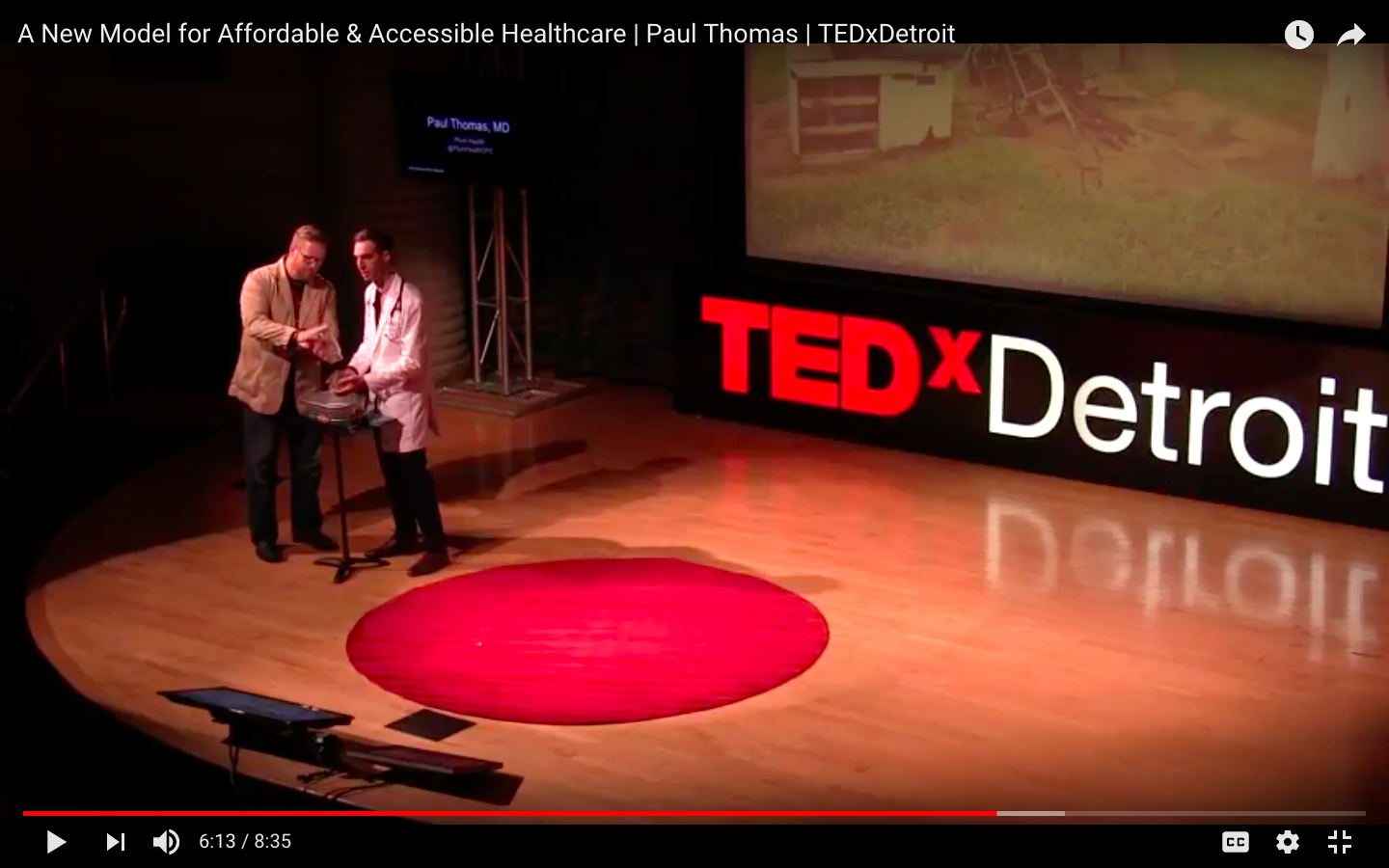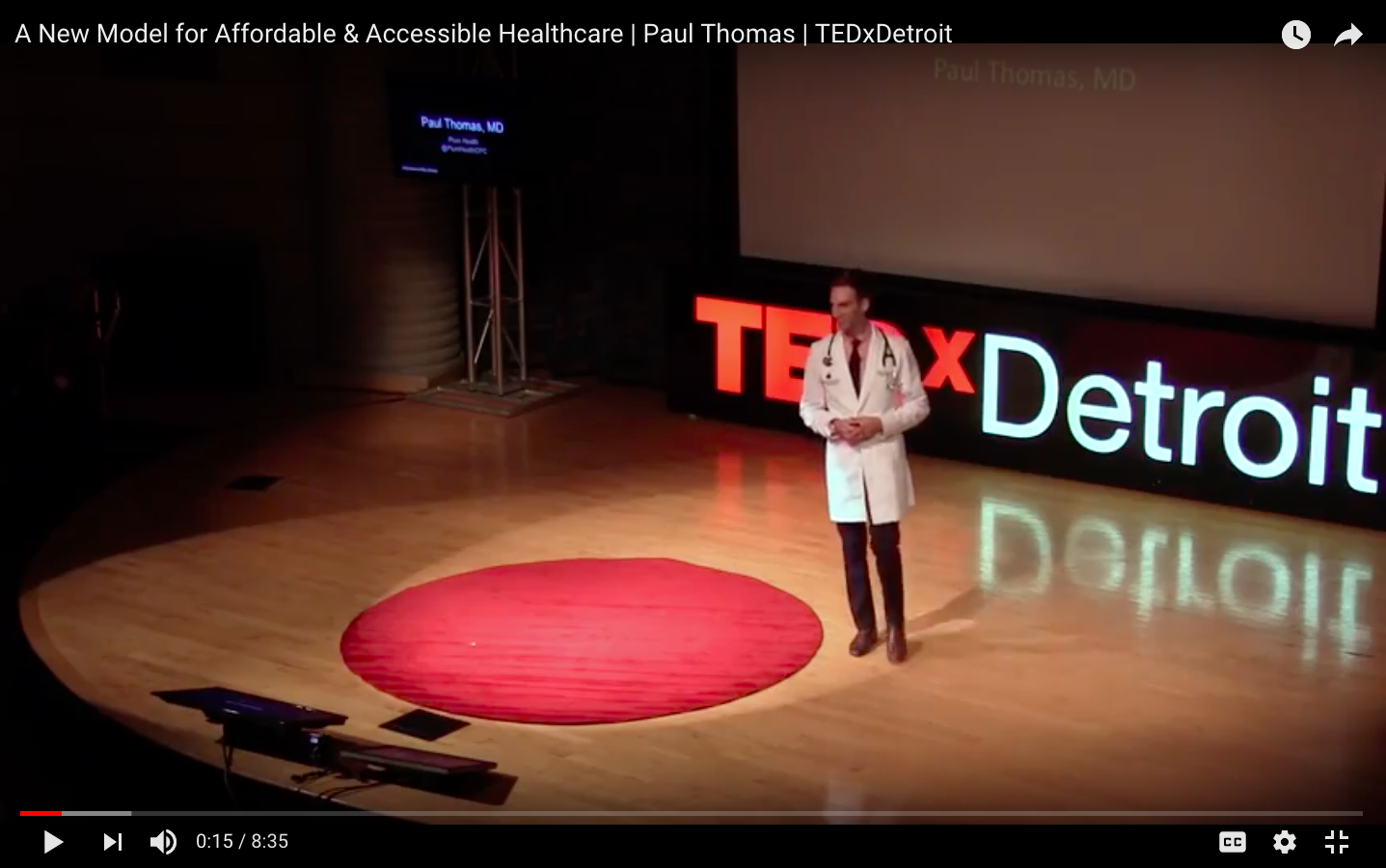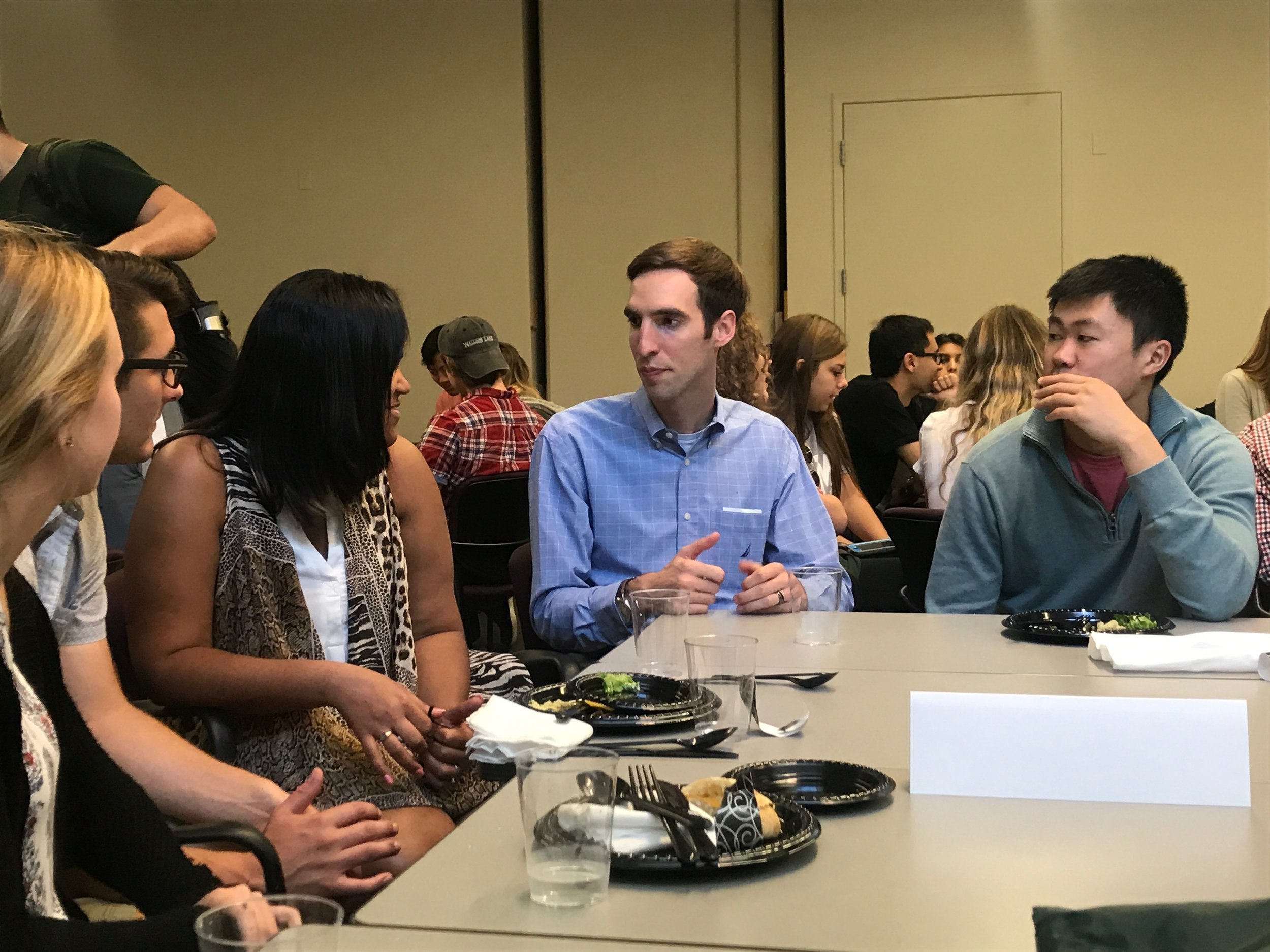Plum Health Blog
Dr. Paul Thomas Interviewed on the Talk2MeDoc Podcast
Dr. Paul Thomas Interviewed on the Talk2MeDoc Podcast
This month, I had a great interview with Andrew Tisser of the Talk2MeDoc podcast. We discussed the direct primary care model and why it’s beneficial for patients and why it’s beneficial for doctors. We talk about primary care, access to care, health disparities, physician burnout, and so much more. Here’s what they had to say:
Join Andrew Tisser with Dr. Paul Thomas as they talk about an exciting new model of primary care. In this episode, you’ll learn:
What is Direct Primary Care?
Benefits of DPC to patients and physicians alike
How to negotiate wholesale prices on labs and imaging
Much more!
Here’s that full episode and below I take a deeper dive into some of these topics.
The Private Medical Practice is Not Dead
During medical school, medical students are told that the only way to have a career in medicine is via an employed model. That simply isn’t true. The private medical practice is not dead. In fact, once you get outside of the health insurance model, the private medical practice is thriving.
When I first started our direct primary care practice back in November of 2016, there were only about 400 practices across the country. Now, there’s over 1,300 direct primary care practices, and the movement continues to grow.
Why? Because patients are looking for kind, caring, and thoughtful physicians who have enough time to fully address all of their concerns. And guess what? The Direct Primary Care model allows doctors to have the time and space to take care of their patients in a comprehensive manner with enough time to fully listen.
Doctor, Heal Thy Self
For too long, primary care physicians have been battling burnout and moral injury by practicing in the fee-for-service model. This has lead to many doctors experiencing burnout and compassion fatigue. As many of 54% of physicians are affected by burnout.
In this podcast episode I make the analogy of half of your lights in your house burning out. If this were to happen, you wouldn’t change each individual lightbulb. Instead, you’d call the big energy company and inquire about the electrical grid in your city, or you’d call up an electrician and have them evaluate the electrical panel in your home.
Yet, when 54% of doctors face burnout, the hospital systems and insurance companies tell them to engage in meditation exercises, retreats, or self-care activities. Sometimes they just tell the doctors to “be more resilient.”
This approach is a slap in the face for hard working and compassionate doctors across our country.
What needs to happen is a comprehensive, systems-based reform of our health insurance and medical care payment systems that uplift the doctor patient relationship rather than forcing doctors into a one-size-fits-all model of high-volume, low-quality patient visits.
About Paul Thomas, MD:
Dr. Paul Thomas is a board-certified family medicine physician practicing in Corktown Detroit. His practice is Plum Health DPC, a Direct Primary Care service that is the first of its kind in Detroit and Wayne County. His mission is to deliver affordable, accessible health care services in Detroit and beyond. He has been featured on WDIV-TV Channel 4, WXYZ Channel 7, Crain's Detroit Business and CBS Radio. He has been a speaker at TEDxDetroit. He is a graduate of Wayne State University School of Medicine and now a Clinical Assistant Professor. Finally, he is an author of two books Direct Primary Care: The Cure for Our Broken Healthcare System and Startup DPC: How to Start and Grow Your Direct Primary Care Practice
You can find Dr. Thomas.
Website: https://www.plumhealthdpc.com/
Facebook: https://www.facebook.com/PlumHealthDPC/
Single Largest Jump in Coronavirus Cases in a 24 Hour Period
Coronavirus Update: United States sees the single biggest increase in cases in a 24 hour period
Unfortunately, the United States has just witnessed the single largest increase in Coronavirus cases of any country in a 24 hour period. Over the last 24 hours, there have been 14,550 new cases reported in the United States according to this website.
Why is the Coronavirus Spreading so quickly in the United States?
It comes down to the concept of R⌀.
R⌀ is the average number of people that an infected person transmits the virus to.
If R⌀ is <1, the epidemic will burn out.
If R⌀ = 1, then epidemic will continue at a steady pace.
If R⌀ >1, the epidemic will increase exponentially.
Current estimates put R⌀ at about 2.5 to 2.9 (Peng PWH et al, 2/28). In plain English, this means that the average person with the Coronavirus will give the virus to 2.5 to 2.9 other people. This transmission rate is a bit higher than seasonal influenza. R⌀ is a reflection of both the virus and also human behavior. Interventions such as social distancing and improved hygiene will decrease R⌀.
Control of spread of COVID-19 in China proves that R⌀ is a modifiable number that can be reduced by effective public health interventions. The R⌀ on board the Diamond Princess cruise ship was 15 – illustrating that cramped quarters with inadequate hygiene will increase R⌀ (Rocklov 2/28).
The Coronavirus started with a single infected person, and it spread to roughly 2.5 to 2.9 other people. Once infected, those people passed the Coronavirus to another 2.5 to 2.9 people each. This is how a virus can exponentially spread. The Coronavirus spread has been hard to diminish because people have a relatively long incubation period or they have the virus and they don’t show symptoms of having the virus for a relatively long period of time, like 5 days to 10 days.
What should I be doing during the Coronavirus pandemic?
Definitely stay at home as much as possible. If you must go outside your home, practice social distancing and act as though you have the virus. Essential tasks done outside the home include buying groceries, making visits to the doctor, and picking up medications from the pharmacy.
How do I protect myself when I go outside?
First, avoid going outside unless you’re going for a walk or otherwise exercising in your neighborhood. If you must go outside, wear disposable latex gloves when you touch high-risk surfaces. For example, when you pump gas at the gas station, put on a pair of latex gloves during the credit card use, key pad entry, and handling the gas pump. Then, dispose of the gloves responsibly in a nearby trash can. Use hand sanitizer once you’re back in your car. Don’t touch your eyes, nose, or mouth after touching potentially contaminated surfaces. You can also use this routine of wearing latex gloves when grocery shopping or when handling a grocery cart.
Is it safe to get food delivered?
Yes, it’s safe to have food delivered and it’s safe to get take-out food. The best practice is to wash your hands after touching any packaging and to wash your hands again before eating. For instance, if you get your food in a brown paper bag, take your food out of the brown paper bag, recycle or discard the brown paper bag, and wash your hands before touching the food or individually wrapped food. Then, transfer the food to a plate or glass bowl and microwave the food for 30 seconds. This will kill any germs or bacteria in or on the food. Wash your hands again prior to eating.
What can you do to boost your immune system?
Many people want to know what they can do to boost their immune system to protect themselves from the Coronavirus. You can do the following to boost your immune system:
Sleep 7 to 9 hours each nigh
Eat nutritious and healthy foods
Drink plenty of fluids, mostly water
Exercise for 1 hour each day
Meditate to keep your stress levels low
When we’re stressed out, we tend to produce more cortisol, a steroid hormone that can weaken our immune system. That’s why it’s important to meditate, sleep well, and exercise.
What are good exercises during the Coronavirus quarantine?
You definitely want to exercise every day during the Coronavirus quarantine. Exercise will be good for your physical health, immune system, and emotional wellbeing. The best exercises will be to go outside of your house for a walk, jog, run, or bike ride. This is one of the few exceptions to the “stay at home” rule above. When you exercise, make sure that you’re keeping your distance from other people by at least 6 feet. You can exercise in your neighborhood or a nearby park. Avoid mall walking or any exercise where you’ll have to open a door/use a door handle for entry. That’s why we recommend folks avoid gyms and pools because there are just too many surfaces that could harbor the Coronavirus and potentially spread the infection. Therefore, exercise at home: lift weights, do floor exercises, do yoga or pilates. Fortunately, several health and fitness companies are giving free 30 day trials of home exercises - take advantage of these programs.
What can you do to slow down the Spread of Coronavirus?
Stay at home.
Act as though you have the virus and any interaction is a potential to spread the virus to a vulnerable person. People who are the most vulnerable are older adults or those with pre-existing medical conditions like lung diseases or cardiovascular diseases.
Do not visit nursing homes or elderly relatives, even if you feel well. You could be an asymptomatic carrier of the coronavirus and you could potentially endanger or kill the older adults that you visit.
Should you be sitting on a stockpile of extra medical supplies and equipment, please donate it to your nearest hospital or primary care physician office. If you have new and unused N95 masks or gloves, please donate them to these healthcare facilities.
Thanks for reading and watching, and have a wonderful day.
-Dr. Paul Thomas with Plum Health DPC
How to Quit Drinking Alcohol in Detroit
The holidays are just around the corner. It’s that time of year we catch up with good friends and loved ones. As we are celebrating, it is important that we safely enjoy our alcoholic beverages. It is also imperative to be transparent with your doctor about the amount of your alcohol consumption as we will discuss more below, can greatly impact your physical health causing chronic ailments like heart disease, high blood pressure, and liver disease. Excessive alcohol use can also be associated with mental health concerns such as depression and anxiety.
What does it mean to be above the legal limit for drinking?
According to the CDC, all states in the United States have adopted a blood alcohol content percentage (BAC) 0.08% as the legal limit for operating a motor vehicle for drivers aged 21 years or older. However, drivers younger than 21 are not allowed to operate a motor vehicle with any level of alcohol in their system.
Legal limits are measured using either a blood alcohol test or a breathalyzer.
Legal limits are typically defined by state law, and may vary according to individual characteristics, such as age and occupation.
What is one “drink” according to the CDC?
12-ounces of beer (5% alcohol content).
8-ounces of malt liquor (7% alcohol content).
5-ounces of wine (12% alcohol content).
1.5-ounces (1 shot glass) of liquor (e.g., gin, rum, vodka, whiskey).
What are the current recommendations for alcohol use?
With the holidays approaching, it is important to drink alcohol in moderation. This means 1 drink per day for women, and 2 drinks per day for men. These recommendations should adhere to the one “drink” standard described above. This means that wine glasses should not be filled to the brim! It is always important to keep in mind that with certain medications interact with alcohol use, including sleeping pills, muscle relaxers or other sedative medications that may make you drowsy. Always be sure to consult your physician and check your prescription bottle for recommendations in regards to alcohol consumption.
Guidelines for Excessive Drinking
According to the CDC, binge drinking includes 4 alcoholic beverages for women, or 5 for men, in a two-hour period. Heavy drinking is considered 8+ drinks per week for women, or 15+ drinks per week for men. Any drinking by a pregnant women or individual under the age of 21 is considered excessive.
What are signs of Alcohol Use Disorder?
Some of the signs and symptoms of alcohol use disorder could include:
Inability to limit drinking.
Continuing to drink despite personal or professional problems.
Needing to drink more to get the same effect.
Wanting a drink so badly you can’t think of anything else.
Health Risks of Alcohol Use
According to the CDC, there are short-term and long-term health risks associated with heavy alcohol use.
Short-Term Health Risks
Excessive alcohol use has immediate effects that increase the risk of many harmful health conditions. These are most often the result of binge drinking and include the following:
Injuries, car crashes, falls, drowning, and burns.
Violence, including homicide, suicide, sexual assault, and intimate partner violence.
Alcohol poisoning, a medical emergency that results from high blood alcohol levels.
Risky sexual behaviors, including unprotected sex or sex with multiple partners. These behaviors can result in unintended pregnancy or sexually transmitted diseases, including HIV.
Miscarriage and stillbirth or fetal alcohol syndrome disorder among pregnant women.
Long-Term Health Risks
Over time, excessive alcohol use can lead to the development of chronic diseases and other serious problems including:
High blood pressure, heart disease, stroke, liver disease, and digestive problems.
Cancer of the breast, mouth, throat, esophagus, liver, and colon.
Learning and memory problems, including dementia and poor school performance.
Mental health problems, including depression and anxiety.
Social problems, including lost productivity, family problems, and unemployment.
Alcohol dependence, or alcoholism.
Signs of Alcohol Withdrawal
After discontinuing alcohol use, within the first 2-4 days days it is possible to have several symptoms including, shakiness, sweating, loss of appetite, nausea, vomiting, headaches and a fast heart rate (also known as tachycardia). More serious symptoms include delirium tremens (DT), seizures and death. Any withdrawal from alcohol should be monitored by your healthcare provider as these symptoms may occur.
Resources for Alcohol Use
Substance Abuse and mental health services’ (SAMHSA) National Helpline number, open 24/7 365 days, 1-800-662-HELP (4357)
For more information on how you can safely consume alcohol this winter, please visit the CDC.
How To Quit Drinking Alcohol in Detroit
If you need help with quitting drinking alcohol, we’re happy to help. We can direct you to the best resources available for alcohol cessation, and we can treat alcoholism in our office. The Sinclair Method is a reasonable treatment option in some cases and it involves taking Naltrexone one hour prior to alcohol consumption. There are also local Alcoholics Anonymous meetings and other support groups that you can attend to help you reduce or eliminate your alcohol consumption.
Thanks for reading and have a great day,
-Dr. Paul Thomas and Dr. Raquel Orlich
How is Plum Health Making an Impact?
Family Medicine Doctor Reaching Out in Detroit
Dr. Paul Thomas speaking to elementary school students at Munger Elementary/Middle School on Detroit's West Side during Career Day.
This week, I engaged in two outreach events, one at Munger Middle Elementary/Middle School on Detroit's West Side and one at the Northwest Activities Center in NW Detroit. The first event had me speaking to a group of about 30 elementary school students, sitting cross-legged on a gym floor. We talked about what it takes to become a doctor, the dreams that they had for their futures, and the steps that it would take to achieve those dreams. They even made me a nice gift for coming out - a small paper doctor.
Dr. Paul Thomas at Munger Elementary/Middle School on the West Side of Detroit.
The event at the Northwest Activities center had me speaking to about 100 senior citizens who had innumerable questions about health and wellness. They asked me about everything from high blood pressure, to diabetes, to nutrition, exercise, arthritis, and declining cognitive function. Also at this event, the community had organized fresh food distribution.
Dr. Paul Thomas at the Northwest Activities Center in NW Detroit after speaking to a group of senior citizens about health and wellness.
Both were inspiring in different ways, and also showed how we can make a big impact by reaching out to the community and educating people from elementary age to senior citizens. I think a lot about impact, and how we're making a positive impact in the community, and I wanted to share an essay I wrote earlier this month:
How a Family Doctor Makes an Impact
The problem that I am solving is access to affordable medical care, not just for individuals, but also for small businesses and communities. On the individual level, I cannot count the number of people who have presented to our clinic to establish care with a family doc for the first time in years, sometimes even decades. They feel comfortable because the price point is understandable, services and charges are transparent, and we've created a welcoming environment for all people.
I’ll give the example of the lifelong Detroit resident who had a uncontrolled blood pressure, who avoided medical care because the cost was simply too high. She signed up for a membership with us, and we are managing her blood pressure with medication that costs under $2/month. She is now at goal, and cried in our office after reaching this critical threshold.
Next, we’re solving a big problem for small businesses. Small business owners want to provide services and benefits that will help them attract and retain employees, and often times traditional health insurance products are financially out of reach. Rather, they choose to provide Plum Health and our health care services for their employees: an affordable product that’s understandable and easy to access for their workers. We are now seeing small businesses that are proud to offer our service as a benefit to their employees as a mean of attracting and retaining talent.
Finally, we’re solving the problem of neighborhood-based primary care services in Detroit, a city that is critically underserved from a primary care perspective. There are fewer than 100 primary care doctors in the City of Detroit, equating to roughly 1 doctor for every 6,300 residents. We are meeting a significant need in our Southwest Detroit location by serving a community that otherwise would not have access.
Thanks for reading, and have a wonderful day,
- Dr. Paul Thomas with Plum Health DPC in Detroit, Michigan
The History of Wayne State University School of Medicine
This week, I was invited to give a presentation on the history of Wayne State University School of Medicine during its Sesquicentennial Celebration. Yes! The WSU SOM is 150 years old, and it has a rich history of diversity, inclusion, and innovation that should be celebrated. Interestingly, the history of the Medical School is the history of the University, as the University grew out of the Medical School. While I can't cover the entire history in a single blog post, I will give some highlights from the early years of the college below. When the full presentation is released later this year, I will post it to the blog as well.
Theodore A. McGraw, MD, founder of the Detroit Medical College, which would later become Wayne State University School of Medicine.
The Detroit Medical College was founded in 1868 by five returning Civil War Veterans. One can only imagine the horrors that they saw on the battlefield and you can also imagine the inadequacy that they felt in treating wounded soldiers. In the 1860's, aseptic surgical techniques were only beginning to be used and anesthesia was not fully understood.
Can you imagine what it might have felt like to be a battlefield clinician, and not having the proper tools or training? Dr. Theodore McGraw, founder of the Detroit Medical College is quoted as saying: "I had discovered in my two years of army activity that I was deficient in that exact knowledge of anatomy that was essential to good surgery. The advent of antiseptic and aseptic surgery, besides, had opened a new field for operative work, that of the abdomen, which demanded a study of anatomical relations which had never been taught in the schools."
Dr. Theodore McGraw was focused on both teaching and learning, and that desire is summed up in this quote "We entered into the matter with unbounded enthusiasm – enthusiasm for teaching and developing ourselves."
To this end, the charter of the Detroit Medical College elucidated how this would be achieved. In the charter (pictured below), it is written that "Pains will be taken to instruct each Student in PRACTICAL DIAGNOSIS. For this purpose the advanced Students will be called upon in turn to examine patients. After pronouncing a Diagnosis, questions will be asked in relation to differential symptoms... ...Little benefit can result to the Student from seeing cases diagnosticated and treated by the Professor of Practical Surgery and Medicine, unless he is first allowed to exert his own powers, and test his own knowledge, by personal examination of the patients."
The Detroit College of Medicine charter from 1868, signed by founding physician Thodore A. McGraw, MD. The charter puts forth the founding principles of the institution.
This ethos of having students practice medicine, to serve the community, and to learn by doing, echoes throughout the history of the School of Medicine. This is the very foundation of the University and the key to its enduring greatness. It is also the reason that I chose to attend WSU SOM - I wanted to immerse myself in the diversity of the city and the breadth of clinical opportunities available in Detroit, from serving homeless and uninsured patients in community clinics to learning from some of the leading minds and researchers in the country at the University clinics.
At its inception, the Detroit Medical College set up a relationship with Harper Hospital and St. Mary's Hospital, which allowed students to learn from and serve the people of Detroit. The focus is, and has always been, learning by doing. The early photos below illustrate these tenets.

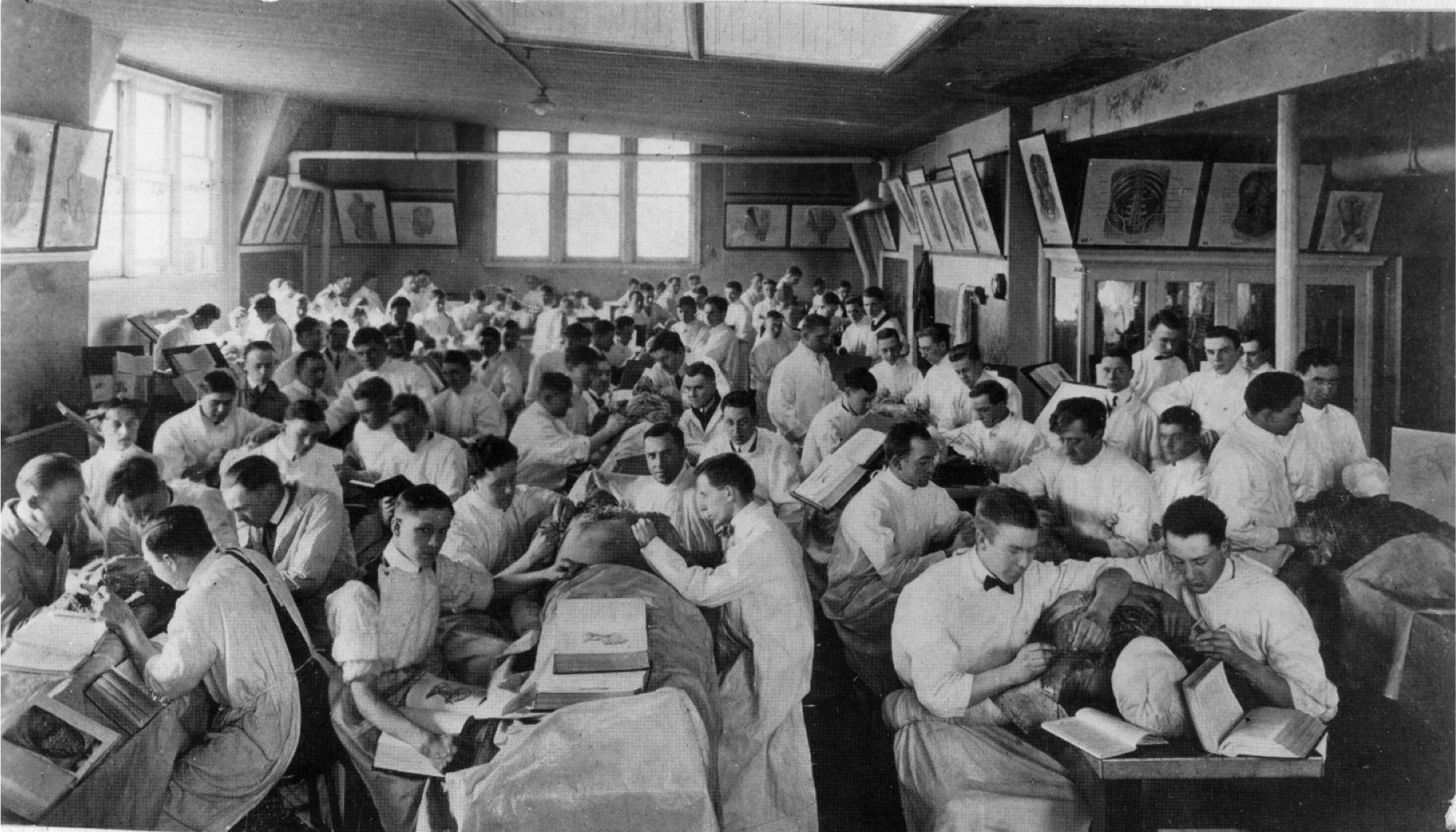
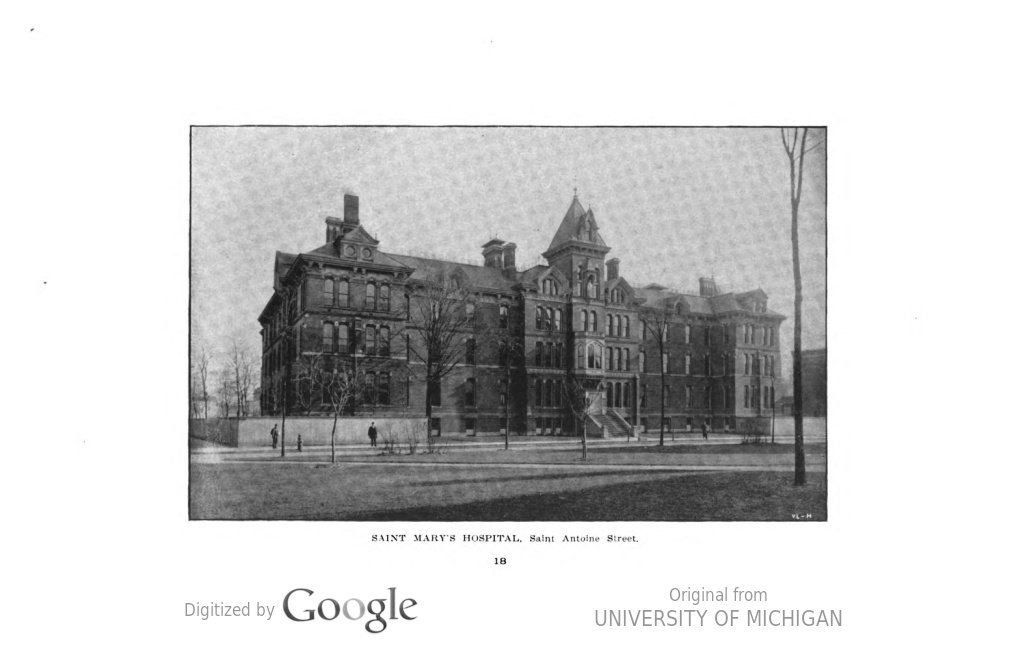
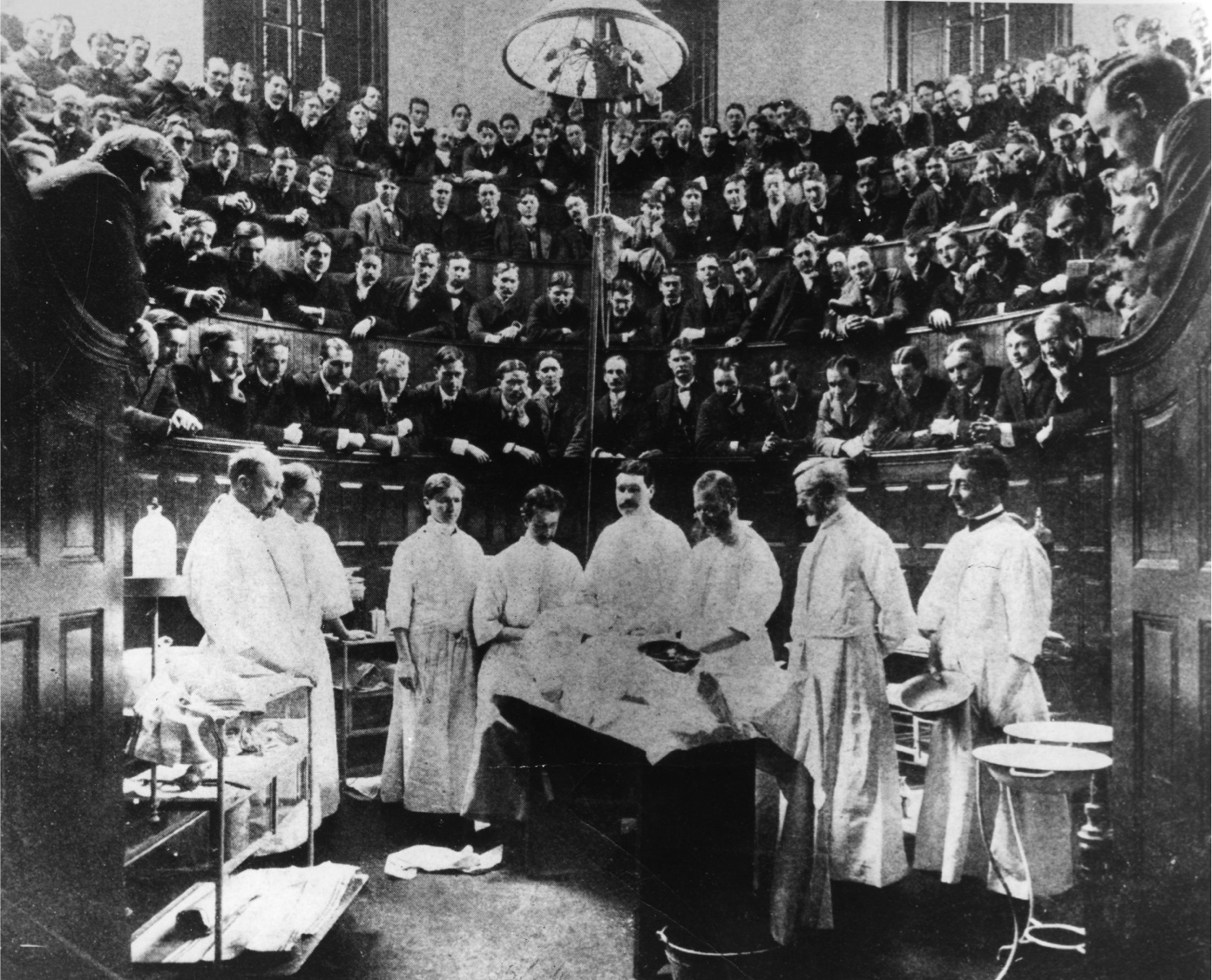
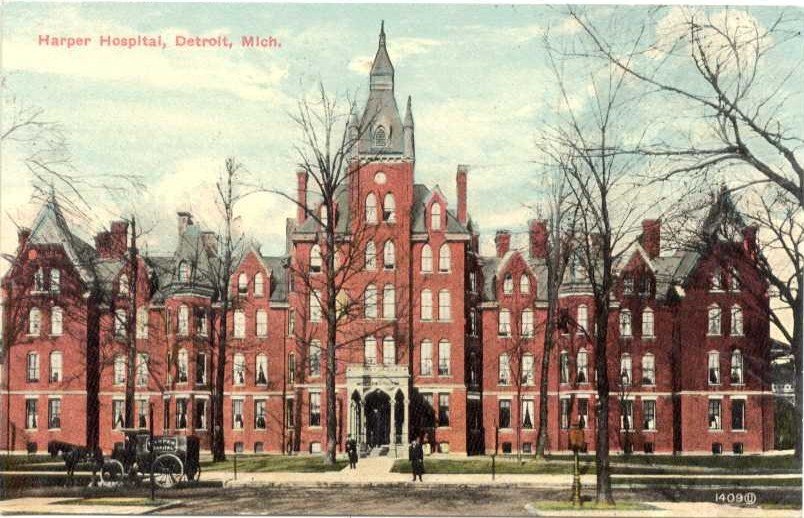
The above photo series include the following images: first is the Detroit Medical College, which housed the medical school after 1868, the second image shows students during anatomy lab sometime around 1900, which is not very different than anatomy lab at the School of Medicine today. The third image is St. Mary's Hospital, one of the two clinical training sites after 1868. The fourth image is the operating theater at St. Mary's Hospital in 1898. The Operator is Dr. Henry O. Walker. At his left, hands behind his back, is Dr. Theodore McGraw, the founder of the Detroit Medical College who emphasized teaching by doing. The final image is Harper Hospital, the primary clinical training site for students at the Detroit Medical College.
It was an honor to be able to relay the history of Wayne State University School of Medicine to my physician colleagues this weekend, and it is a great reminder of what makes doctors from Wayne State unique and so skilled - the focus on hands-on clinical training and the diversity of the people we have the privilege of serving.
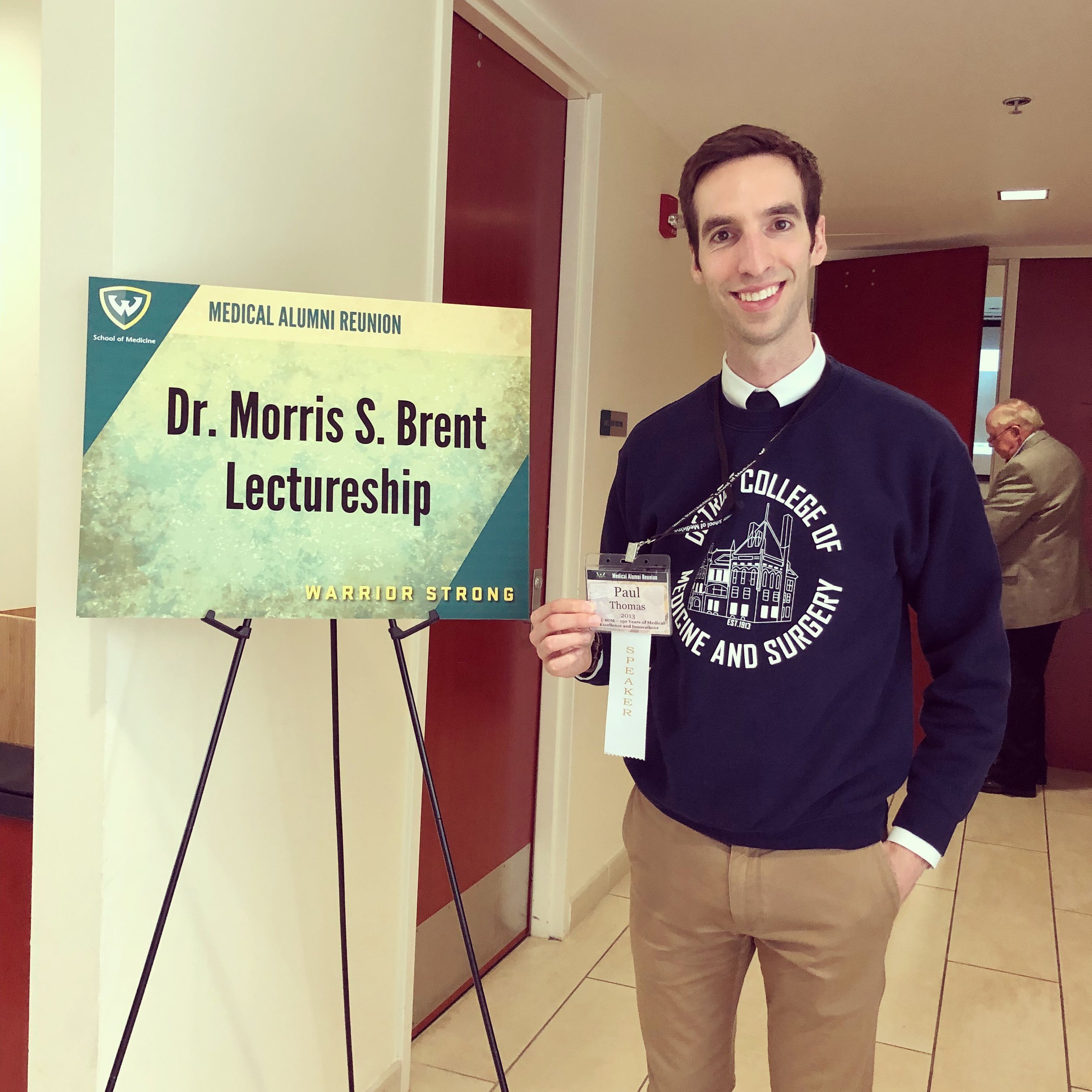
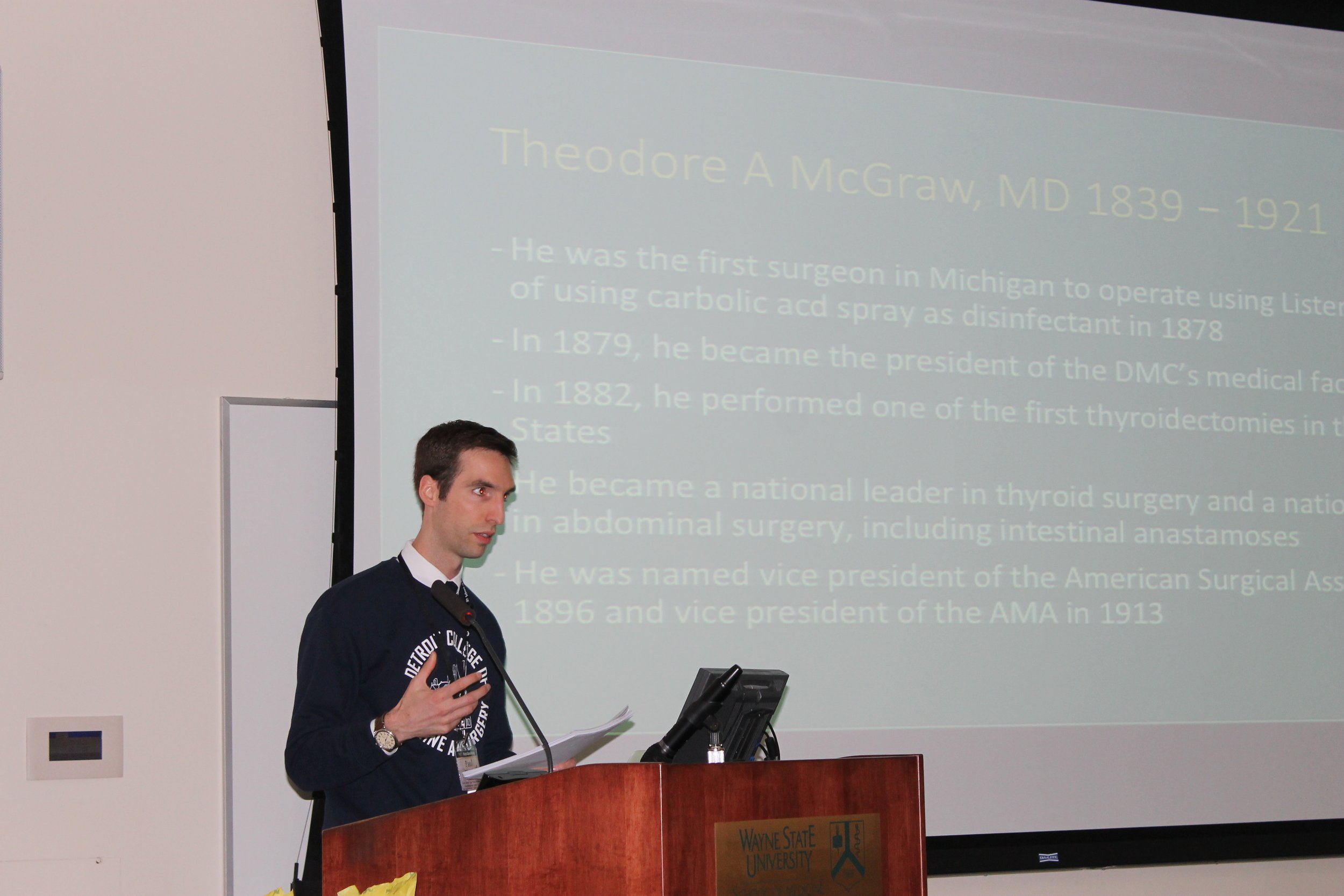
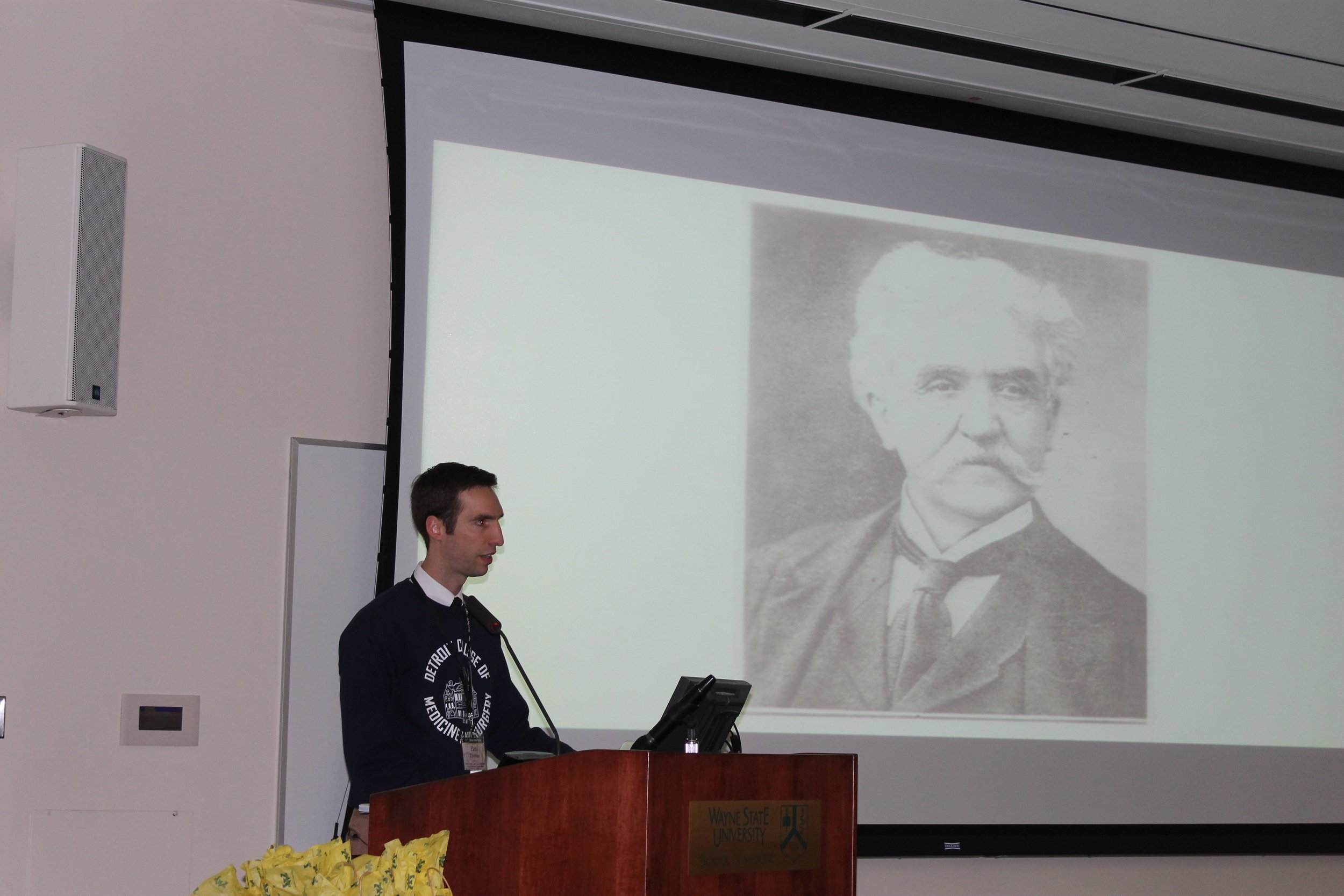
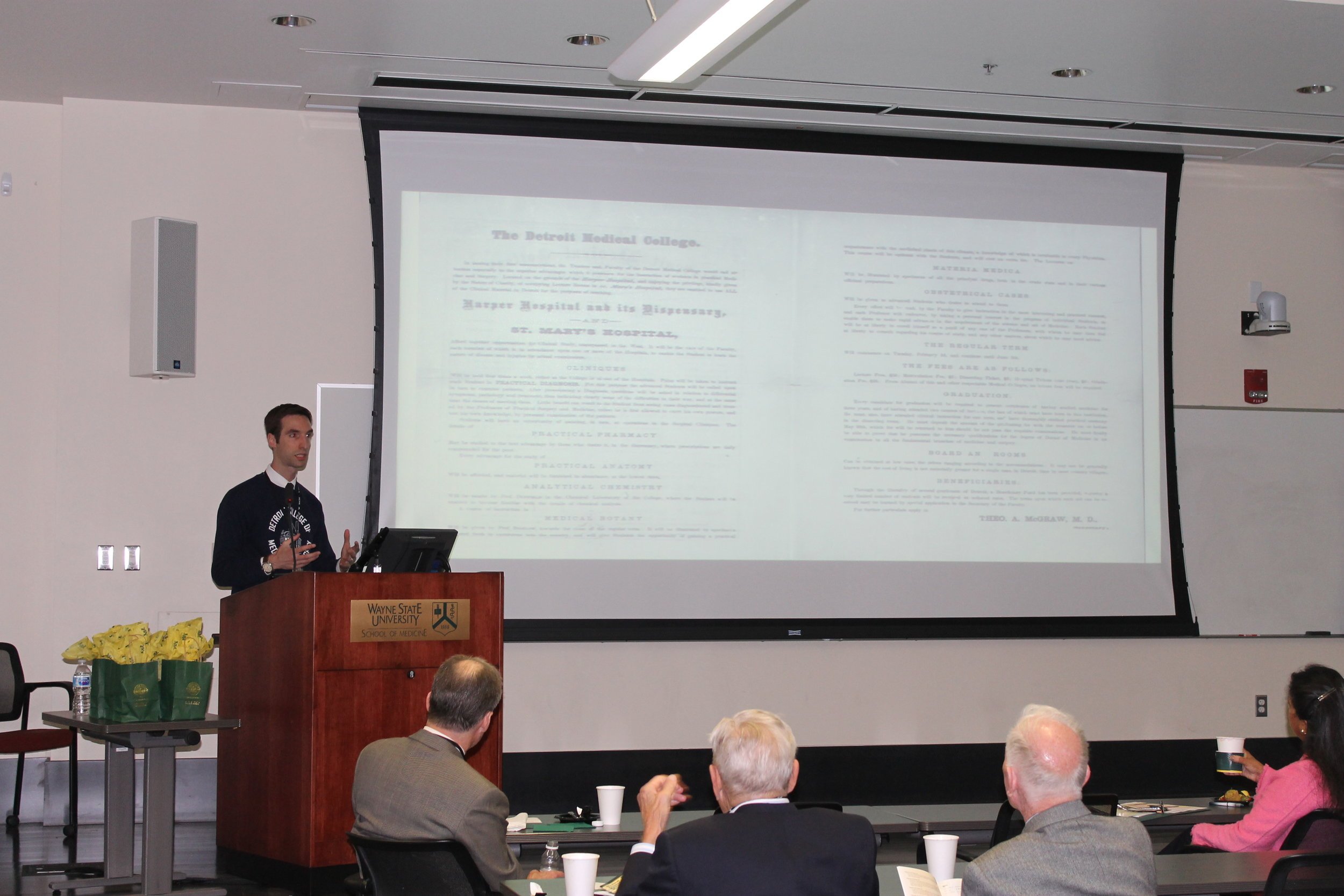
Thanks for reading,
- Dr. Paul Thomas, Physician with Plum Health DPC
Plum Health on Bonfires of Social Enterprise
Last month, I had the pleasure of being interviewed by Romy Kochan on her podcast, Bonfires of Social Enterprise. Bonfires of Social Enterprise is focused on highlighting social entrepreneurs and we were happy to be featured on this podcast!
I believe that Plum Health DPC is a social enterprise because we not only focus on growing the business in a traditional sense (revenue, profit & loss, etc...), but we also focus on making a positive impact in the community by providing a medical service that is much needed the SW Detroit community.
Romy was a great interviewer and made me think differently about my own practice, prompting me to say something I've never said before. She asked if I could dream big, and envision a future for what I'm doing, what could this look like?
I responded by saying, "I think this could look like a nation where we get rid of these old notions of what 'good health care' looks like, and starting to realize that it doesn't look like a piece of plastic in our wallet. It looks like a relationship with someone in our community that is a healer, that can listen, and has time to address your concerns".
The conversation had a broad scope from how we got started, to the impact we're having, to the reaction to our service from the community. Here's how Romy describes it:
We’re back with another episode here on social enterprise. We have a doctor on this show who has been making a big impact in Detroit. It is Dr. Paul Thomas of Plum Health Care DPC. He has a dream of changing the notion of health care from a plastic card in your wallet to true healing from a healing doctor! What a concept!
This was a wonderful interview and I am so grateful to Romy Kochan for having me on her podcast. Check out the full episode here, and have a healthy week!
- Dr. Paul with Plum Health DPC
PS: you can find this episode on the podcasting platform of your choice:
PRX.org (Public Radio Exchange)
PPS: Follow us on Instagram!
Paul Thomas MD TEDxDetroit Video
THE DAY HAS FINALLY ARRIVED! Our talk at TEDxDetroit has been posted on YouTube! Check it out here:
In case you missed the original blog post after the TEDxDetroit event, check out my thoughts on speaking during the event, here.
Thanks for reading and have a wonderful day!
- Dr. Paul Thomas with Plum Health DPC
Mentoring Students at Wayne State University School of Medicine
Part of my mission, part of the "why" behind what I do, is to educate medical students and inspire them to choose a career in primary care specialties. Primary care doctors have the greatest impact on their communities, have the most tools at their disposal, and are most able to bend the cost curve in the health care ecosystem.
As a part of that mission, I spend a good amount of time interacting with medical students at Wayne State University School of Medicine (WSUSOM). This week, I took part in two different events at WSUSOM. The first was a mentoring session for first year students and the second was a mock interview session for the fourth year students.
For the first year students, it's an opportunity to get to know each other, learn from each other, and to be a resource. For the fourth year students, it's an opportunity to help them polish their interviewing skills as they prepare for the next step in their careers - residency!
This next generation of doctors will face significant changes and challenges in the health care system - from greater automation, to precision medicine, to even Artificial Intelligence. I hope that I can be a part of the foundation along with their formal education at WSUSOM that sets them on the right path to success in medicine.
Thanks for reading, and have a beautiful day,
- Dr. Paul Thomas with Plum Health DPC
Why It's Important to Have a Family Medicine Doctor in Detroit
Today I had the pleasure of speaking with Keith White of the Cancer Awareness Resource Network. We talked over the phone about his organization, the work we're doing with Plum Health, and the potential that we have to serve folks with cancer in Detroit and beyond.
Keith has had an amazing and inspiring journey. To read about him, check out what he wrote on his "about us"page. One thing Keith realized, though, is that even if folks have great health insurance, they may still have really high co-pays for doctor's visits and medications. He reached out to see what Plum Health could offer those with cancer and those in remission in his network.
Simply put, we can offer the best primary care experience in Detroit. What that means is that you have a Family Medicine Doctor or a Primary Care Doctor who is truly your advocate. I take my role seriously, and I will advocate for your health and wellbeing, your family and your finances while you confront cancer. How do we do this?
First, I focus on you and take a wholistic approach to your care. I have more time to spend with you, to get to know you and understand where you're coming from, what you're dealing with, and where you want to go with your life and your health. As your family doc, I will make sure that you're taking the right medications, that you are getting the right screening tests, and keeping up with treatment.
Second, I take care of folks in the context of their families and their communities. If there are emotional or familial stressors, we can talk about those and look for solutions together.
Third, I watch out for the financial wellbeing of my patients. This means that I make my prices clear and understandable, I don't charge co-pays for visits, and I give my members medications at wholesale prices.
Cancer and its treatment are hard enough, so when facing these difficulties, you want a primary care doctor who knows you well and who can advocate on your behalf.
Thanks for reading, and have a wonderful day,
Dr. Paul Thomas with Plum Health
The current look of our Plum Health Direct Primary Care office in Detroit, Michigan
What is Family Medicine?
Hello, this is Dr. Paul Thomas with Plum Health DPC and I'm a Family Medicine Doctor in Detroit. I operate Plum Health Direct Primary Care, which delivers affordable, accessible health care services in Detroit.
This week, I'm talking about Family Medicine Week, an official announcement from Governor Rick Snyder that makes February 19th - 25th Family Medicine Week. I'm a month late in bringing this up, but it's still important to recognize Family Medicine and the contribution of Family Medicine Doctors across the State of Michigan.
For starters, Family Medicine Doctors compete four years of undergraduate education, four years of medical school, and three years of residency. That's 11 years after high school and 7 years after college. Furthermore, some Family Medicine Doctors sub-specialize within Family Medicine.
They complete a 1 year fellowship to become Sports Medicine doctors, or Family Medicine doctors that sub-specialize in adolescent medicine, geriatric medicine, addiction medicine, etc...
The point is that Family Medicine doctors are highly trained, and specialize in taking care of the whole patient in the context of the family and the community.
Family Medicine doctors care for people of all ages and stages! We help deliver babies, we help infants meet developmental milestones, we complete school, work, and sports physicals, we take care of injuries like fractures and lacerations, and we take care of chronic conditions like diabetes, high blood pressure, and asthma.
Family Medicine doctors also work across a variety locations. Family Medicine doctors work in emergency departments, in-patient hospital settings, and out-patient clinics. Family Medicine doctors lead health departments for Cities, Counties, and States. Family Medicine doctors teach at medical schools, volunteer at homeless clinics, and travel abroad with organizations like Doctors without Borders.
Personally, I love being a Family Medicine Doctor - I love taking care of people regardless of their age, race, gender, and orientation. I love being able to offer care and compassion to those who need it, along with the standard medical care.
Finally, we need more Family Medicine doctors to create healthy communities, healthy cities, and a healthy nation. Family Medicine doctors address small issues before they become big, complicated problems. Family Medicine doctors and Primary Care Physicians can effectively increase the health of a community and lower the cost of care in that community.
Primary Care and Family Medicine is vital, and I'm glad that we have a week to recognize the work that Family Medicine doctors carry out each day in the State of Michigan.
Thanks for your time, and have a wonderful day,
- Dr. Paul Thomas
February Update
Hey everybody! It's February 2nd and time for an update about our services and a little bit of an overview about what we do. January was our first full month of operation in a brick-and-mortar space and we were able to have 20 new members join the practice! We are currently located at 1759 West 21st Street, Detroit, MI.
What makes them want to join? First it's our dedication to great service. When you make an appointment, you typically get 1 hour of uninterrupted time with me, Dr. Paul Thomas. We talk about your medical history, review any records that you bring, perform a physical exam, draw any blood samples if necessary and give any medications if necessary.
The great thing about our Direct Primary Care model is that we get these labs at-cost and the medications at whole-sale prices. Our lipid panel is about $7 and our Comprehensive Metabolic Panel is about $4. Our current price for Azithromycin or a "Z-pak" is $1.15. We sell Lisinopril for about $0.40/month. Yes, you read that correctly! Forty cents for a one month supply of Lisinopril.
I give Flu shots for $10.53, Hepatitis A vaccine for $68.42, Tetanus Diphtheria and Acellular Pertussis (TDaP) vaccine for $47.47. Our price for Metformin is $0.40/month if you take 1 pill each day and $0.80/month if you take 2 pills each day. I recently dispensed Augmentin for a skin infection for $4.82.
If you're interested in this type of care: more time with your doctor, clear and consistent pricing, the ability to have easier communication with your doctor via text and email, you should sign up for our services.
You can either call 313.444.5630 to set up an appointment or enroll on our website, here.
Thank you for watching and reading, and have a great day!
- Paul Thomas, MD
Plum Health + Vitamin D
Vitamin D deficiency can be a big problem in the winter months, especially if you live up in Michigan! At Plum Health, we delivery direct primary care services, meaning that we can get you wholesale medications and at-cost laboratory services, including Vitamin D Levels and Vitamin D supplements.
You should have a vitamin D level of 20 - 50 ng/mL - some experts in the field recommend 20 - 40 ng/mL as the appropriate range, others recommend 30 - 50 ng/mL as the best range. However, experts agree that a Vitamin D level of less than 20 ng/mL can lead to problems with skeletal health.
Having a sub-optimal vitamin D level can lead to osteoporosis, an increased risk of falls and possible fractures. Additionally, having a low vitamin D level can put you at risk for immune problems and cardiovascular problems.
We make vitamin D in our skin, and this production is aided by sunlight. The American Academy of Family Physicians (AAFP) noted that "humans typically obtain 90 percent of vitamin D from sunlight". Unfortunately, because of low sunlight levels in the winter, our Vitamin D production ceases in temperate areas like Detroit, Edmonton, and Boston.
Furthermore, you are at an increased risk of having low vitamin D levels if you are sedentary, if you have dark skin, if you are obese, if you are over 65 years of age, or if you take medications that alter Vitamin D metabolism, like steroids or seizure medications.
So, unless you are a young, active snowbird, it is wise to take a vitamin D supplement to offset your lost productivity in the winter months. According to the AAFP, a 3.5 ounce piece of fresh, wild-caught salmon has roughly 600 - 1,000 international units of vitamin D. Other sources of dietary vitamin D include tuna with 230 IU's for every 3.6 ounces consumed and milk at 100 IU's for every 8 ounces consumed.
If you'd rather get your vitamin D in pill form, Vitamin D3 or cholecalciferol comes in doses of 400, 800, 1,000 or 2,000 IU's. These can be purchased over the counter, but it is best to talk to your primary care doctor before deciding on which dose is appropriate for you.
Thanks for reading and have a great day!
Paul Thomas, MD, Family Medicine doctor in Detroit, Michigan






